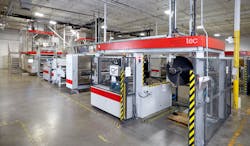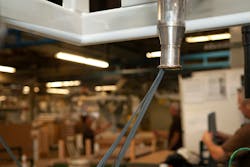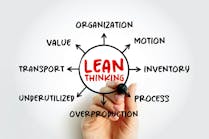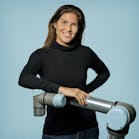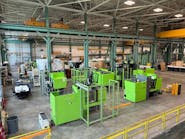By Ron Shinn and Allan Gerlat
Whether it is drool, skeleton scrap, trim or flash, the detritus of plastics processing is something every processor is under pressure to deal with as efficiently as possible.
Not too many years ago, it was mostly sent to a landfill at a cost that processors considered an ordinary business expense. But as transportation and landfill costs rose, processors sold it or paid re-processors to haul it away.
Today, everyone knows that reducing the amount of scrap and re-using what is produced is an environmental necessity and impacts the bottom line. That attitude starts with the way processors think about the resin that comes into their plants.
“It is taking ownership of [resin] from cradle to grave, and not letting there be a grave,” said Jim Hoffman, president of Rapid Granulator. “People want to do the right thing.”
The following are stories about how some processors deal with their scrap.
Lacerta
The Lacerta Group generates 15 million to 20 million pounds of scrap a year, and at one time it sold it all at a loss to plastics recyclers. But a $6 million investment this year in extrusion equipment means the manufacturer of thermoformed packaging will finally be able to close the loop and use all of it in-house, along with some post-consumer material customers want in their packaging.
Lacerta continues to invest in Starlinger equipment to expand its in-house recycling operation.Lacerta Group Inc.The Mansfield, Mass., company, which makes primarily food packaging, has one shredder and two granulators from Zerma that run 24 hours a day processing skeleton scrap and trim material. Skeletons are the sheet that remains after the package has been cut out. The shredder and two granulators cannot keep up with scrap from Lacerta’s 31 thermoforming lines, which will grow to 33 lines later this quarter.
The granulated material is decontaminated and filtered, then mixed with virgin resin and put back into Lacerta’s sheet extrusion lines.
The $6 million investment is for a Starlinger Viscotec extrusion line. The investment includes building modifications and utility installation for the new equipment. The line joins two previously installed Starlinger lines.
The new Starlinger line, due to be installed in July, will include a decontamination unit and the ability to improve the intrinsic viscosity of the PET sheet. It will extrude multilayer sheet that is FDA approved for direct food contact and contains as much as 100 percent post-consumer resin (PCR).
Some of Lacerta’s customers want PCR content, so currently Lacerta must buy post-consumer flake from outside vendors. The Starlinger system will enable it to process all of its requirement and decontaminate the flake in-house.
“We have been growing the amount of skeleton we could reuse by 25 percent to 30 percent every year, but with the new Starlinger line we will be able to process 100 percent of our regrind and improve the quality of it in the process,” Lacerta President Ali Lotfi said.
Lotfi said adding the reprocessed material back into his products is “absolutely far more valuable to us” than selling it.
Lacerta, a family-owned company, added 95,000 square feet of production space to its four-building campus in Mansfield last year and launched a 100,000-square-foot plant in Chatsworth, Calif., that has seven thermoforming lines. Total employment has grown from 240 to 400 in the past year.
Production is still ramping up in the Chatsworth plant and scrap is currently sold to an outside vendor. Lotfi said that Lacerta is committed to sustainability. It sees significant benefit in using PCR and will continue to invest in the process.
Evco
Injection molders who work with expensive materials and very thin profit margins know that scrap is important.
“Most of us know that the actual material value is typically 50 percent of our total cost,” said Gary Fortier, director of U.S. operations for Evco Plastics in DeForest, Wis. “Our focus is to find ways to prevent scrap. That is the key to being profitable.”
Evco makes sure its parts are well-designed, the molding machine and mold are expertly maintained and set up correctly, the best material is selected and properly handled, scientific molding principles are applied and operators are trained. Everything is according to best practices.
“But at the end of the day, scrap happens,” Fortier said.
Evco performs injection molding at five plants in the U.S., three in Mexico and one in China. It molds a wide range of products for markets including the medical industry.
Fortier said that medical molding operations have very little opportunity to reuse scrap since virgin resin is nearly always required. “We do have runners and things like that that we cannot use back onto the molding process,” he said. “We still protect that as a valuable asset. We grind it, recover it and are able to resell it.”
The bad news is that Evco typically gets 5 cents to 15 cents per pound for material it buys for $2 per pound. “But we are not putting it into the landfill,” Fortier said. “We are recouping some value.”
The equation is better for Evco’s non-medical molding operations. Scrap can be shredded, filtered and put back into a product at whatever percentage the customer has agreed to accept.
“There were times we did not have large enough grinders, so we would put large rejected parts on a flat trailer and sell them for scrap,” he said. “We don’t do that at any location now. Today, everything is ground and reused or sold for the best value we can get.”
In cases involving large parts, such as 20-pound agricultural parts, large Zerma shredders are placed behind the molding machines so rejected parts can be shredded, fines removed and the material filtered and blended back into the molding machine. This prevents the need for bulky parts to be moved around the plant.
When it comes to machines molding smaller parts, excess material and rejects are transported to a central location, where the material is shredded, and the fines removed and filtered, and dried if necessary, Then, the regrind goes into gaylords before being eventually moved back to a molding machine.
Evco has several brands of shredders and separators. Shredders are used either for specific materials or cleaned after each shredding.
Evco is building a 38,000-square-foot addition to its Oshkosh, Wis., molding plant, and it is creating a dedicated area farther away from the presses for shredding. The greater distance will allow Evco to better protect its reground material from contamination.
Entek
Entek International never has to deal with disposing of trim or other scrap that is a by-product of the high-value separator sheet it manufactures for lead-acid batteries and the separator film it makes for lithium-ion batteries.
At Entek International, a company-built system transports trim material to a reprocessing station where it is turned back into pellets before being reused.Entek InternationalThe company’s film extrusion lines around the world are equipped with a home-built system that transports the trim material to a reprocessing station where it is turned back into pellets, then reintroduced into the extruder. No human intervention is required.
The system was engineered by sister company Entek Manufacturing, which builds the well-known Entek twin-screw extruders. Both Entek companies are headquartered in Lebanon, Ore.
“Without Entek Manufacturing’s engineering, we would not have this technology,” said Larry Keith, CEO of the Entek family of companies. “They developed, invented, installed and commissioned the system.
“When we first started making separator sheet, we landfilled the trim. Entek extruders saw the amount of waste we had and went to work on the engineering solution.” Entek Manufacturing builds the extrusion lines for the battery separator business.
Keith estimated that about 10 percent of the total PE Entek processes turns out to be trim or is rejected for technical reasons. That is the material that was once landfilled but is now reprocessed. “We have very, very little waste,” he said.
Lead-acid battery separators are made by mixing a specialty grade of amorphous silica, ultra-high-molecular-weight PE, oil and a few other ingredients in smaller quantities, then pushing the mixture through a die with a 133mm Extek extruder at 392 degrees Fahrenheit. This forms an oil-filled sheet that is then calendered to the desired thickness. A rib pattern is embossed during calendering.
Larry KeithEntekAfter calendering, most of the oil is extracted with a trichloroethylene bath. Next, the sheet goes through a steam process to remove most of the solvent; then,it is dried, wound and slit into separate strips. The individual strips are wound into rolls, each containing about 6,000 feet of material. Battery makers turn the sheet into envelopes for battery plates.
The mixture going into the extruder is more than 60 percent oil; the finished product contains about 15 percent oil, which helps the separator material last for five years or longer in battery acid.
The reprocessing station is about 600 feet away from the newest sheet line at Entek. The trim is conveyed by materials-handling fans to the secondary processing station, where it goes through a Rapid granulator, then into an Entek extruder with an underwater pelletizing system from Gala, a Maag Group company. Pellets are automatically transported back using a dense-phase process and reintroduced to the sheet line.
Entek does not reveal details on how it manufactures separator film for smaller lithium-ion batteries.
Entek extruder customers can also buy the trim-handling system. Keith said a similar system is currently being built for an Entek customer that extrudes sheet.
Alltrista Plastics
Alltrista Plastics has a zero-tolerance policy for sending plastics to the landfill.
“We don’t put any of that into the dumpster,” said Chris Navratil, CTO with Jadex Inc., parent company of Alltrista Plastics in Greer, S.C.
Purgings used to be a problem for the molder of bottles and packaging for consumer, medical and health-care products. “Like everyone did at one time, we spread some cardboard on the floor to catch purgings from start-ups, shutdowns and maintenance,” Navratil said. “But we found out that cardboard raises havoc for our recyclers and they asked us to stop putting cardboard into our purgings.”
Alltrista invested in purge pans — aluminum pans with insulated handles that are similar to baking trays for sheet cake. “The purge comes out and it creates a nice, uniform block. As it cools, we can put the blocks into our containment area,” he said.
Jadex and Alltrista, along with three other Jadex business units, were spun off from publicly held Newell Rubbermaid in May 2019. At that time, Jadex was known as Jarden Plastic Solutions. Jadex is now privately held.
“Most of our products are low-scrap-generation,” Navratil said. “We don’t deal with any cold-runner material. Everything is hot runners.”
He said the medical scrap that Alltrista shreds and sells to recyclers is “first-pass material and is fairly desirable to some of the second-source companies” that can use it to produce their wide-spec recycled resin.
For non-medical products, Alltrista typically shreds the scrap and blends the regrind back into the molding machines at a 10 percent to 15 percent level.
An initiative that has paid off in several ways, including scrap reduction, has been working with customers to reduce the amount of resin in their products. “We are constantly working with our customers to reduce the amount of material by 10 percent,” Navratil said. “That reduces their cost, improves our productivity and reduces end-of-life issues for products.”
All five Alltrista molding plants have shredders, but generally not beside-the-press units, since most of the company’s products are small enough to be easily moved to a shredder.
Plastic that is shredded is mixed with other material of the same type and stored in gaylords until it is needed.
Navratil said the company has also learned to use technology better to control scrap. Many of its injection molding machines are from Netstal, part of the KraussMaffei brand, and have purging programs in their control systems. The control system will automatically stop the purging cycle when a pre-set number of purging strokes has been reached.
“That means we don’t have to worry about someone setting the auto purge in motion and forgetting to pull back the hopper when they walk away,” he said. “If you don’t use a program to alert you when the necessary number of purging strokes has been exceeded, it will keep purging hundreds of pounds of material.
“We have become much more conscious about using those types of programs to prevent human error from creating a lot of additional scrap,” Navratil said.
Ron Shinn, editor
Contact
Alltrista Plastics, Greer, S.C., 864-879-8100, www.alltrista.com
Entek Manufacturing, Lebanon, Ore., 541-259-1068, http://entek.com/
Evco Plastics, DeForest, Wis., 800-507-6000, www.evcoplastics.com/
Lacerta Group Inc., Mansfield, Mass., 508-339-3312, http://lacerta.com/
Ron Shinn | Editor
Editor Ron Shinn is a co-founder of Plastics Machinery & Manufacturing and has been covering the plastics industry for more than 35 years. He leads the editorial team, directs coverage and sets the editorial calendar. He also writes features, including the Talking Points column and On the Factory Floor, and covers recycling and sustainability for PMM and Plastics Recycling.

